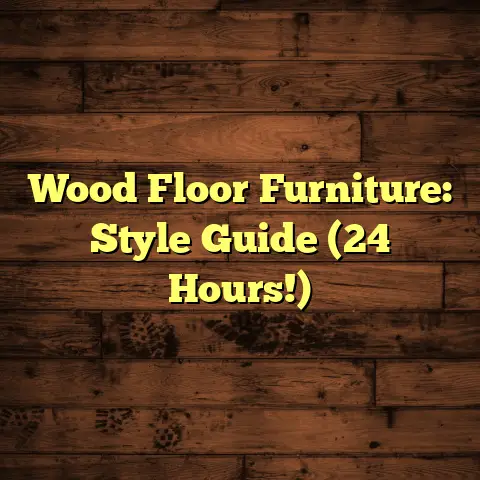Bolting a Safe to Wood Floors (3 Mistakes Kill!)
Today, we’re diving into a topic close to my heart (and your valuables): bolting a safe to wood floors.
It’s a fantastic way to boost your home security, but trust me, there are pitfalls.
I’m going to walk you through the right way to do it and highlight three killer mistakes that could compromise everything.
Let’s get started!
1. Understanding the Importance
of Securing Your Safe
Let’s face it, the world isn’t always sunshine and rainbows.
According to the FBI, in 2022, there were an
estimated 857,948 burglaries in the United States.
(Source:
FBI Uniform Crime Reporting (UCR) Program).
That’s a sobering thought.
A good safe is your first line of defense, but an unsecured safe is just a heavy box waiting to be carted away.
Bolting it down offers serious advantages.
-
Deterrence: Thieves often look for
easy targets.
A bolted safe is a much harder target
than one that can be easily moved. -
Increased Safety: Bolting prevents
tipping during natural disasters like
earthquakes. -
Peace of Mind: Knowing your valuables
are secure allows you to sleep better
at night.
And who doesn’t want that?
2. Choosing the Right Location
for Your Safe
Okay, so you’re ready to commit. Great! But where do you put this thing?
Location, location, location! It’s not just for real estate.
Here are some factors I always consider:
-
Accessibility: You need to be able to
get to your safe easily.
No point in hiding it so well that you
can’t access it quickly in an emergency. -
Discretion: Obviously, you don’t want
it in plain sight.
Think about areas that aren’t immediately
visible when someone enters your home. -
Proximity to Power: If you have a safe
with electronic features, you’ll need
access to a power outlet.
I always advise against high-traffic areas like hallways or living rooms.
Think about bedrooms, closets, or even underneath stairs.
These spots offer a degree of concealment while still being accessible.
Common Mistakes:
-
Ignoring Floor Support: Don’t put a
heavy safe on a floor that can’t handle
the weight.
We’ll talk more about this later. -
Placing it in Plain Sight: Seriously,
I’ve seen safes practically in the middle
of living rooms.
That defeats the whole purpose! -
Forgetting About Access: Can you easily
open the safe door in the chosen location?
Make sure there’s enough clearance.
3. Selecting the Appropriate
Safe for Your Needs
Not all safes are created equal. Choosing the right one is crucial.
Let’s break down the main types:
-
Fire-Resistant Safes: Protect documents
and valuables from fire damage.
These are rated by the amount of time
they can withstand certain temperatures. -
Waterproof Safes: Protect against
water damage from floods or sprinkler
systems. -
Burglary-Rated Safes: Designed to
resist forced entry.
These have different ratings based on
the tools and time it would take to break in.
Consider what you’re protecting. Important documents? Jewelry? Firearms?
The size, weight, and security features should all align with your specific needs.
Mistakes I See All the Time:
-
Buying Too Small: You’ll always need
more space than you think.
Trust me on this one. -
Ignoring Security Ratings: Don’t skimp
on security.
A cheap safe is often easily defeated. -
Forgetting About Fire Protection: Even
if you’re primarily concerned about theft,
fire protection is a smart investment.
4. Tools and Materials Needed
for Installation
Alright, let’s get practical.
Here’s what you’ll need to bolt that safe
down like a pro:
-
Drill: A good quality drill is essential.
Ideally, you’ll want a hammer drill if
you’re dealing with concrete subfloors. -
Drill Bits: You’ll need bits appropriate
for both wood and the type of anchors
you’re using. -
Wrench Set: For tightening the bolts.
-
Socket Set: Sometimes sockets are easier
to use than wrenches, depending on the
bolt placement. -
Level: To ensure the safe is perfectly
level.
This is important for smooth operation
and preventing strain on the locking mechanism. -
Measuring Tape: For accurate placement.
-
Pencil/Marker: For marking drill locations.
-
Safety Glasses: Protect your eyes!
Seriously, don’t skip this. -
Gloves: Protect your hands.
-
Shop Vac: For cleaning up dust and debris.
-
Bolts and Anchors: This is where it gets
tricky.
We’ll dive deeper into this in a later
section, but make sure you choose bolts
and anchors specifically designed for
wood floors.
Common Oversights:
-
Using the Wrong Drill Bits: Using a
wood drill bit on concrete will ruin
the bit and won’t get the job done. -
Skipping Safety Gear: It’s not worth
the risk. -
Not Having the Right Size Wrench:
Frustration guaranteed.
5. Step-by-Step Guide to Bolting
a Safe to Wood Floors
Okay, time for the main event! Here’s how to bolt that safe down, step-by-step:
Step 1: Preparing the Area
-
Clear the area where the safe will be
placed.
Remove any rugs or furniture. -
Clean the floor thoroughly.
You want a clean surface for marking
and drilling.
Step 2: Marking the Safe’s Position on the Floor
-
Carefully position the safe in your
chosen location. -
Use a pencil or marker to mark the
outline of the safe on the floor. -
Open the safe door and locate the pre-drilled
bolt holes inside. -
Use a marker to transfer the location
of these holes onto the floor.
Be precise!
Step 3: Drilling Holes for the Bolts
-
Using the correct size drill bit for
your chosen anchors, drill pilot holes
at the marked locations on the floor. -
Important: Drill straight down!
Angled holes will make it difficult
to insert the bolts properly. -
Drill deep enough to accommodate the
length of your anchors.
Step 4: Securing the Safe to the Floor
-
Position the safe back over the drilled holes.
-
Insert the bolts through the safe’s bolt
holes and into the anchors in the floor. -
Tighten the bolts securely using a wrench
or socket.
Don’t overtighten, as this could damage
the wood or strip the threads.
Step 5: Ensuring the Safe is Level and Stable
-
Use a level to check if the safe is perfectly
level. -
If it’s not level, use shims (thin pieces
of wood or plastic) under the safe to
adjust the height. -
Once level, double-check that all bolts
are still tight.
Mistakes to Avoid During the Process:
-
Drilling Too Deep or Too Shallow:
Measure carefully! -
Stripping the Bolt Threads: Don’t
overtighten! -
Forgetting to Level the Safe: A
wobbly safe is a security risk and
can damage the locking mechanism.
6. Mistake #1: Not Checking
the Floor Structure Before Installation
This is HUGE. Seriously, this is where I see so many people go wrong.
Bolting a heavy safe to a weak floor is like building a house on sand.
It doesn’t matter how strong the safe is if the floor gives way.
Signs of a Weakened Floor:
-
Sagging: Visible dips in the floor.
-
Soft Spots: Areas that feel spongy
or give way under pressure. -
Squeaking: Excessive squeaking can
indicate loose floorboards or weakened
joists. -
Water Damage: Stains, discoloration,
or rot.
How to Assess the Integrity of the Wood:
-
Visual Inspection: Look for any of
the signs listed above. -
Sound Test: Tap on the floor with a
hammer.
A solid sound indicates good wood.
A hollow or dull sound suggests rot
or damage. -
Probe Test: Use a screwdriver or
awl to probe the wood.
If it easily penetrates, the wood is
likely weakened.
Consequences of Ignoring This Step:
-
Floor Collapse: The weight of the
safe could cause the floor to collapse. -
Compromised Security: A weakened floor
makes it easier for thieves to remove
the safe. -
Costly Repairs: Fixing a damaged floor
can be expensive.
My Advice:
If you have any doubts about the integrity of your floor, consult a professional.
It’s better to be safe than sorry. (Pun intended!)
7. Mistake #2: Using the Wrong Type
of Bolts or Anchors
Okay, let’s talk hardware. The choice of bolts and anchors is absolutely critical.
Using the wrong type can render your entire installation useless.
Why is This So Important?
The bolts and anchors are what physically connect the safe to the floor.
If they’re not strong enough or not designed for wood, they can easily fail under stress.
Common Types of Bolts and Anchors for Wood Floors:
-
Lag Bolts: Large, heavy-duty screws
that are designed to bite deeply into wood.
These are a good option for solid wood floors. -
Sleeved Anchors: These anchors expand
as you tighten the bolt, providing a
strong grip. -
Expansion Bolts: These are generally used
for concrete, but there are some wood-specific
expansion bolts available.
Risks Associated with Incorrect Hardware:
-
Pull-Out: The bolts or anchors can
pull out of the wood under stress. -
Stripped Threads: Overtightening can
strip the threads, weakening the connection. -
Corrosion: Using non-galvanized bolts
in damp environments can lead to corrosion
and failure.
My Recommendation:
Consult with a hardware professional to determine the best type of bolts and anchors for your specific floor and safe.
Don’t just grab the cheapest option off the shelf.
Invest in quality hardware. It’s worth it.
8. Mistake #3: Neglecting to
Camouflage the Safe
You’ve bolted your safe down, great! But don’t stop there.
Making it less visible to potential intruders is the next crucial step.
Think of it as adding another layer of security.
Why is Camouflage Important?
The less obvious your safe is, the less likely a thief is to target it.
Out of sight, out of mind.
Techniques for Disguising a Safe:
-
Furniture Placement: Place a sofa,
chair, or bookshelf in front of the safe. -
Decor: Hang a picture or tapestry over
the safe. -
False Bottoms: Build a false bottom
in a closet or cabinet to conceal the safe. -
Rugs: Place a rug over the safe,
making sure it’s large enough to completely
cover it.
Examples of Poor Disguises:
-
A Thin Blanket: Easily pulled away.
-
A Small Plant: Doesn’t conceal much.
-
An Obvious “Hiding Spot”: Thieves
know where to look.
My Pro Tip:
Think creatively!
The best disguises are the ones that blend
seamlessly into your home decor.
Make it look natural.
9. Conclusion: Securing
Your Peace of Mind
We’ve covered a lot of ground today, folks.
From understanding the importance of securing your safe to avoiding those critical mistakes that can compromise your security.
Remember, bolting a safe to your wood floor is a smart investment in your peace of mind.
But it’s only effective if done correctly.
If you’re feeling uncertain about any of these steps, don’t hesitate to call in a professional.
Sometimes, the cost of professional installation is worth the assurance that the job is done right.
Ultimately, protecting your valuables is about more than just securing a safe.
It’s about securing your peace of mind.
So take your security seriously, avoid these common mistakes, and rest easy knowing that your possessions are safe and sound.
Thanks for tuning in, and stay secure!





